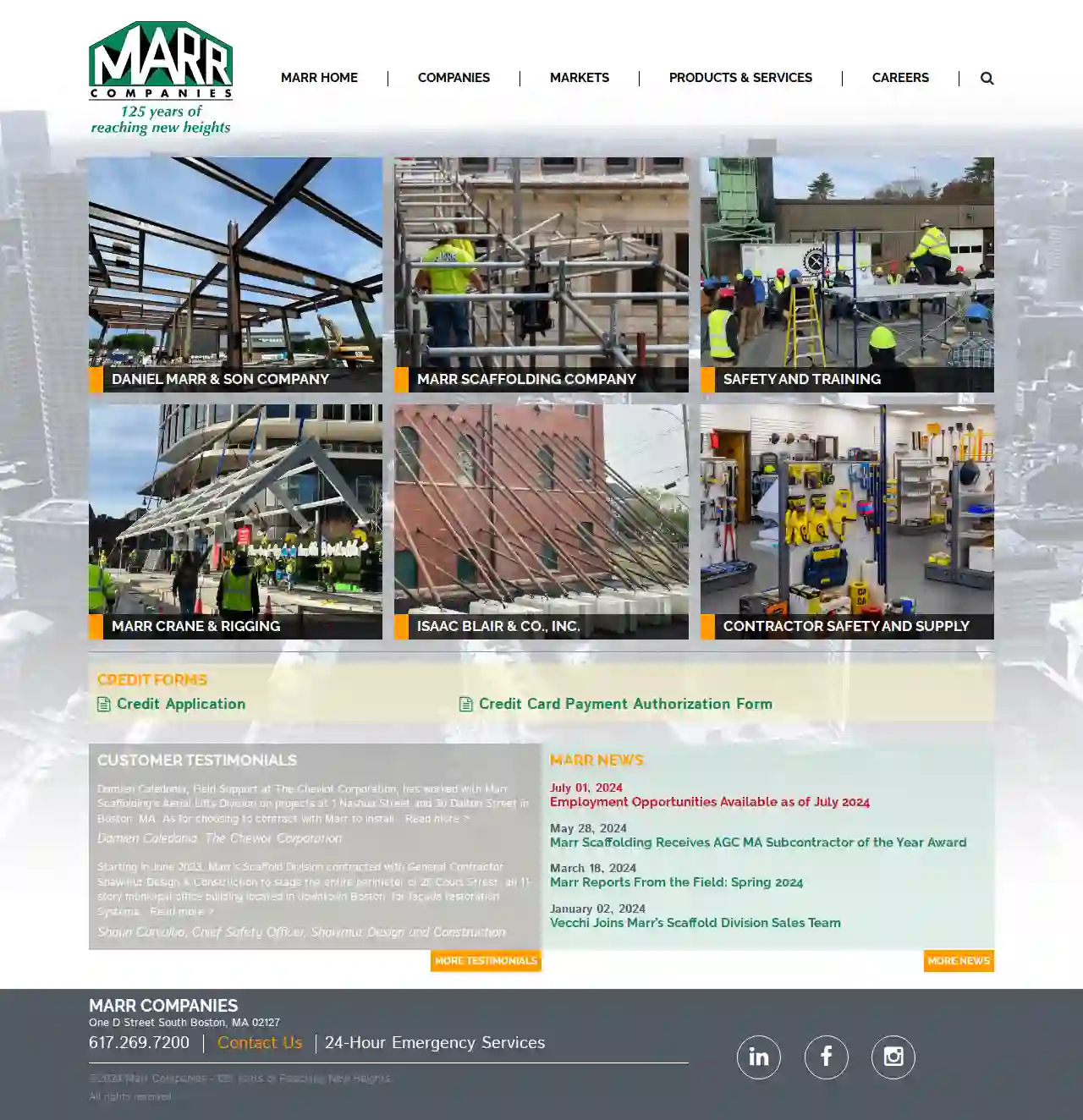Scaffolding Companies North Providence
Find the best Scaffolding Contractors in North Providence
Get 3 FREE Scaffolding Companies quotes for your project today! Compare profiles, reviews, accreditations, portfolio, etc... and choose the best service.

Marr Scaffolding Company - Providence
44 reviewsOne D Street South Boston, MA, Boston, 02127, USMarr Companies: A Legacy of Excellence For over 125 years, Marr Companies has been a trusted leader in the construction industry, providing a wide range of services and products to meet the needs of our clients. Our commitment to safety, quality, and customer satisfaction has earned us a reputation for excellence throughout the region. Our Mission Our mission is to provide our clients with the highest quality construction services and products, delivered safely and efficiently. We strive to build lasting relationships with our clients, based on trust, respect, and a shared commitment to excellence. Our Values Our values guide everything we do. We are committed to: Safety First Quality Workmanship Customer Satisfaction Integrity and Ethics Teamwork and Collaboration Our Experience Our team of experienced professionals has a deep understanding of the construction industry and a proven track record of success. We are committed to providing our clients with the best possible service and support, from the initial planning stages to the final completion of the project.
- Services
- Why Us?
- Gallery
Get Quote
Atlas Scaffolding & Equipment
51 reviewsWarwick, RI, 80 Gilbane Street, 02886, USAtlas Scaffolding & Equipment is a full-service scaffolding, shoring, and trash chute equipment rentals, sales, installation, and dismantling services company. Established in 1997, they cater to contractors, municipalities, and industrial customers throughout Rhode Island, Southeastern Massachusetts, and parts of Connecticut. Their main facility is located at 80 Gilbane Street, Warwick, RI. Known for their excellent safety record, quick and responsive service, free estimates, full insurance, strict OSHA compliance, and membership in the SIA, Atlas Scaffolding is a trusted name in the industry.
- Services
- Why Us?
- Accreditations
- Our Team
- Testimonials
- Gallery
Get Quote- Ne
Newport Builders' Supply Co
Providence, US- Services
- Why Us?
Get Quote
Over 2,353+ Scaffolding Businesses in our network
Our scaffolding contractors operate in North Providence & surrounding areas!
ScaffoldingHQ has curated and vetted the Best Scaffolding Companies in North Providence. Find a reliable contractor today.
Frequently Asked Questions About Scaffolding Companies
- Falls from Height: The most significant risk, often due to lack of guardrails, improper use of safety harnesses, or unstable platforms.
- Falling Objects: Tools, materials, or debris falling from the scaffolding can injure workers or people below.
- Scaffold Collapse: Improper assembly, overloading, or inadequate foundation support can lead to a catastrophic collapse.
- Electrocution: Contact with overhead power lines is a serious hazard when working near electrical infrastructure.
- Slips, Trips, and Falls: Wet or cluttered platforms, uneven surfaces, and loose debris can cause falls.
- Experience: 'How long have you been in business, and what experience do you have with projects like mine?'
- Licensing and Insurance: 'Are you fully licensed and insured, and can I see proof of coverage?'
- Safety Record: 'What are your safety procedures, and how do you ensure worker safety on the job site?'
- References: 'Can you provide references from previous clients?'
- Quotes and Costs: 'Can you provide a detailed quote that outlines all costs, including materials, labor, and any additional services?'
- Project Timeline: 'What is the estimated timeframe for scaffolding erection and dismantling?'
- Communication: 'How will you communicate with me throughout the project?'
What are some common scaffolding safety hazards?
Can I erect scaffolding myself?
What questions should I ask a scaffolding company before hiring them?
What is a scaffolding hoist?
What are some common scaffolding safety hazards?
- Falls from Height: The most significant risk, often due to lack of guardrails, improper use of safety harnesses, or unstable platforms.
- Falling Objects: Tools, materials, or debris falling from the scaffolding can injure workers or people below.
- Scaffold Collapse: Improper assembly, overloading, or inadequate foundation support can lead to a catastrophic collapse.
- Electrocution: Contact with overhead power lines is a serious hazard when working near electrical infrastructure.
- Slips, Trips, and Falls: Wet or cluttered platforms, uneven surfaces, and loose debris can cause falls.
Can I erect scaffolding myself?
What questions should I ask a scaffolding company before hiring them?
- Experience: 'How long have you been in business, and what experience do you have with projects like mine?'
- Licensing and Insurance: 'Are you fully licensed and insured, and can I see proof of coverage?'
- Safety Record: 'What are your safety procedures, and how do you ensure worker safety on the job site?'
- References: 'Can you provide references from previous clients?'
- Quotes and Costs: 'Can you provide a detailed quote that outlines all costs, including materials, labor, and any additional services?'
- Project Timeline: 'What is the estimated timeframe for scaffolding erection and dismantling?'
- Communication: 'How will you communicate with me throughout the project?'